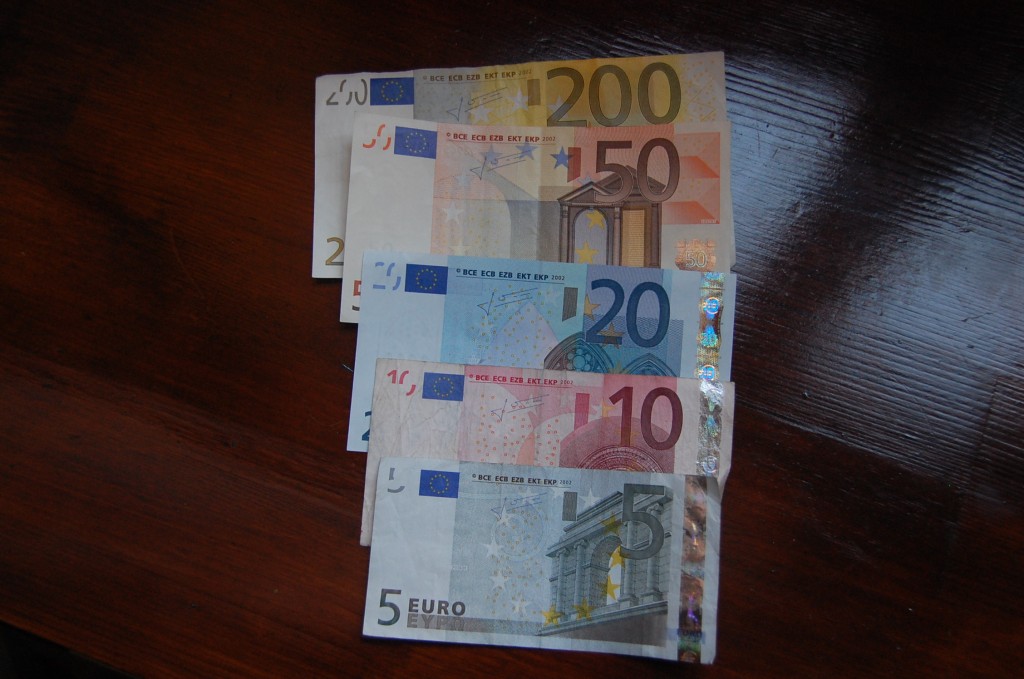A lot has changed when it comes to payments in Italy. You can now use credit cards widely, but other contactless payment services like Venmo and ApplePay are less common around the country. That means that how much cash to bring to Italy really depends on the kinds of purchases that you plan to make. For example, all major attractions and accommodations will accept credit cards, so it is not as though you have to carry very large sums with you.
As a general rule of thumb, bills less than €10 tend to be paid in cash. This means that you should have bills and coins with you for things like:
- Coffee (typically €1 – €2)
- Public transportation (€1.50 per trip)
- Street food (like pizza slices and gelato)
- Short taxi trips
- Fresh food markets (fruit and vegetables, etc)
- City hotel tax
This means that a majority of your budget can be handled on credit cards, but you will need cash for the smaller everyday aspects of experiencing Italy.
To elaborate on the above:
- Coffee bars sometimes do not have credit card machines. Even if they do, they are unlikely to accept very small payments by card. Since a typical Italian breakfast of a cappuccino and a pastry should cost about €2.50, you should plan to keep that much in cash per day.
- You can actually use apps to pay for public transportation like bus tickets in Rome, but if you plan to buy your tickets in person at a tabacchi, you should have cash.
- Gelateria and other street food places tend to be a bit like coffee bars in the sense that they *might* accept cards if you are ordering over €10 worth of food. However, it is better to have cash to be safe.
- Taxis should technically be required to accept cards, but some will tell you that they can only take cash for short trips.
- If you want to shop like an Italian at a fresh food market, you should bring cash. These stands and greengrocers usually only accept bills and coins rather than debit or card payments.
- While accommodation can be paid by card, some cities will only accept the nightly tourist tax (e.g. hotel tax) in cash. This can range from €1-€8 per person per night and is usually paid as a lump sum at check-in or check out.
Large expenses such as hotel bills should always be paid by card. In Italy, it is actually illegal to make cash payments over €1,000. This is done to limit tax avoidance.
If you plan to go to supermarkets, you can always use a card, regardless of how small your bill is.
Tipping in Italy is not mandatory, but you should always leave the gratuity in cash if you do want to tip. Options to add a tip to the credit card bill really don’t exist here yet. The exception is if you are ordering goods or services through an app – in many cases, you can add a tip before your virtual check out.
And before you decide to put everything on your credit card, make sure you are using one without foreign transaction fees. The conversion rates that are offered on the POS machines that ask you to press 1 for USD or 2 EUR are always markups that will cost you quite a bit in the end.
Example Daily Cash Budget for Italy
- €2 for coffee
- €1 for a bottle of water
- €3 for gelato
- €7 for transportation
- €5 for a small glass of wine
- €10 for a small souvenir
So you could carry €25 – €30 in cash for a day with plenty of discretion depending on how you budget and what you skip. You could sub a pizza slice for the wine, or limit yourself from buying cute souvenirs, for example.
Regional Differences
These credit card and cash rules apply in all Italian cities. However, if you are staying in a small town with lots of locally owned businesses, cash may be even more appreciated than usual. And keep in mind that a credit card machine requires a data connection so if you are staying somewhere rural, you may run into trouble paying by card.
Helpful Words to Know
- Credit card: carta di credito
- POS: the acronym is pronounced as a word and stands for ‘point of service’ – a credit card machine
- Cash: contanti
- Cash payment: pagamento in contanti
- Money: soldi
- Change: spicci
- Coins: monete
I hope this helps with your Italy trip budget! Do you have other questions about using cash in Italy?






Since the 80s when we had to wait in line to cash travelers checks, the prolific bancomat has made life easier. I have learned to use those attached to banks to avoid the very high fees associated with the independent ones on street corners. Some banks will forgo those fees if you need their high balance requirements. Cash is essential and the AT< is best way to get it. Always a good idea to have an extra debit card in case there is a problem with your regular bank. Rare but it does happen.
Another excellent place to get cash in Italy is the ATM machine at the post office. Where we stay on Lake Como in the summer, we only pay a 75 cent fee with our credit union per transaction. So keep an eye out for those Post Offices, they are very helpful!
That’s a great transaction fee! Chase charges more..
Ciao Natalie! This is another one of your super helpful and throughout post, brava!
I always wonder how you come up with them, but I guess like you said. People ask you stuff… you write posts to answer their questions…
Thanks, Thea!
Great advice. When I lived in Brindisi, made multiple trips to Roma and always told visitors exactly what you state here. Yes, expect about 30-30 eyes a day to spend
Thanks for the great advice Natalie; and to your contributors, too. I’m heading for the Rome area for two months to hopefully experience garden to table cooking there. Traveled to Venice, central and north Italy several times; now, I want to visit southern Italy and tool around. If you have any recommendations for restaurants to visit, I’d appreciate it! I’m retired U.S. military with an Italian heritage – not writing a cookbook, but am interested in learning how to do it myself. 🙂